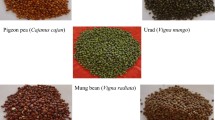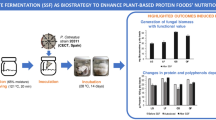Abstract
The present work investigates the probable bioprocessing technique to mobilize the bound phenolics naturally found in finger millet cell wall for enriching it with dietary antioxidants. Comparative study was performed between the exogenous enzymatic treatment and solid-state fermentation of grain (SSF) with a food grade organism Rhizopus oryzae. SSF results indicated that at the 6th day of incubation, total phenolic content (18.64 mg gallic acid equivalent/gds) and antioxidant property (DPPH radical scavenging activity of 39.03 %, metal chelating ability of 54 % and better reducing power) of finger millet were drastically enhanced when fermented with GRAS filamentous fungi. During the enzymatic bioprocessing, most of the phenolics released during the hydrolysis, leached out into the liquid portion rather than retaining them within the millet grain, resulting in overall loss of dietary antioxidant. The present study establishes the most effective strategy to enrich the finger millet with phenolic antioxidants.




Similar content being viewed by others
References
Cassano A, Donato L, Conidi C, Drioli E (2008) Recovery of bioactive compounds in kiwifruit juice by ultrafiltration. Innov Food Sci Emerg 9:556–562
Ramachandra G, Virupaksha TK, Shadaksharaswamy M (1977) Relationship between tannin levels and in vitro protein digestibility in finger millet (Eleusine coracana Gaertn). J Agri Food Chem 25:1101–1104
Kumari LP, Sumathi S (2002) Effect of consumption of finger millet on hyperglycemia in non-insulin dependent diabetes mellitus (NIDDM) subjects. Plant Foods Hum Nutr 57:205–213
Hegde PS, Chandrakasan G, Chandra TS (2002) Inhibition of collagen glycation and crosslinking in vitro by methanolic extracts of Finger millet (Eleusine coracana) and Kodo millet (Paspalum scrobiculatum). J Nutr Biochem 13:517–521
Chethan S, Malleshi NG (2007) Finger millet polyphenols: characterization and their nutraceutical potential. Am J Food Tech 2:582–592
Bhanja T, Kumari A, Banerjee R (2009) Enrichment of phenolics and free radical scavenging property of wheat koji prepared with two filamentous fungi. Bioresour Tech 100:2861–2866
Pinelo M, Sineiro J, Núñez MJ (2006) Mass transfer during continuous solid-liquid extraction of antioxidants from grape byproducts. J Food Eng 77:57–63
Pérez-Jamiréz J, Saura-Calixto F (2005) Literature data may underestimate the actual antioxidant capacity of cereals. J Agric Food Chem 53:5036–5040
Yu J, Vasanthan T, Temelli F (2001) Analysis of phenolic acids in barley by high-performance liquid chromatography. J Agric Food Chem 49:4352–4358
Vattem DA, Shetty K (2002) Solid-state production of phenolic antioxidants from cranberry pomace by Rhizopus oligosporus. Food Biotech 16:189–210
Workman W, Day DF (1982) Purification and properties of, β-glucosidase from Aspergillus terreus. Appl Environ Microbiol 44:1289–1295
Ayaz FA, Hayirlioglu-Ayaz S, Gruz J, Novak O, Strnad M (2005) Separation, characterization, and quantitation of phenolic acids in a little-known blueberry (Vaccinium arctostaphylos L.) fruit by HPLC-MS. J Agric Food Chem 53:8116–8122
Quettier-Dele C, Gressier B, Vasseur J, Dine T, Brunet C, Luyckx M (2000) Phenolic compounds and antioxidant activities of buckwheat (Fagopyrum esculentum Möench) hulls and flour. J Ethnopharmacol 72:35–42
Brand-Williams W, Cuvelier ME, Berset C (1995) Use of free radical method to evaluate antioxidant activity. LWT Food Sci Technol 28:25–30
Dinis TCP, Madeira VMC, Almeida LM (1994) Action of phenolic derivates (acetoaminophen, salycilate and 5-aminosalycilate) as inhibitors of membrane lipid peroxidation and as peroxyl radical scavengers. Arch Biochem Biophys 315:161–169
Benzie IFF, Strain JJ (1996) The Ferric reducing ability of plasma (FRAP) as a measure of ‘‘antioxidant power’’: the FRAP assay. Anal Biochem 239:70–76
Hilu KW, De WJMJ, Seigler D (1978) Flavonoid patterns and systematics in Eleusine. Biochem Sys Ecol 6:247–249
Lee IH, Hung YH, Chou CC (2008) Solid-state fermentation with fungi to enhance the antioxidative activity, total phenolic and anthocyanin contents of black bean. Int J Food Microbiol 121:150–156
McCue P, Horii A, Shetty K (2003) Solid-state bioconversion of phenolic antioxidants from defatted soybean powders by Rhizopus oligosporus: role of carbohydrate-cleaving enzymes. J Food Biochem 27:501–514
Chauve M, Mathis H, Huc D, Casanave D, Monot F, Ferreira NM (2010) Comparative kinetic analysis of two fungal β-glucosidases. Biotechnol Biofuels 3:1–3
Shahidi F, Janitha PK, Wanasundara PD (1992) Phenolic antioxidants. Crit Rev Food Sci Nutr 32:67–103
Yamaguchi T, Takamura H, Matoba T, Terao J (1998) HPLC method for evaluation of the free radical-scavenging activity of foods by using 1,1-diphenyl-2-picrylhydrazyl. Biosci Biotechnol Biochem 62:1201–1204
Chinnici F, Bendini A, Gaiani A, Riponi C (2004) Radical scavenging activities of peels and pulps from cv. Golden Delicious apples as related to their phenolic composition. J Agric Food Chem 52:4684–4689
Maisuthisakul P, Pasuk S, Ritthiruangdej P (2008) Relationship between antioxidant properties and chemical composition of some Thai plants. J Food Compo Anal 21:229–240
Dar BN, Sharma S (2011) Total phenolic content of cereal brans using conventional and microwave assisted extraction. Am J Food Technol 6:1045–1053
Sun T, Tang J, Powers JR (2007) Antioxidant activity and quality of asparagus affected by microwave-circulated water combination and conventional sterilization. Food Chem 100:813–819
Sripriya G, Chandrashekharan K, Murty VS, Chandra TS (1996) ESR spectroscopic studies on free radical quenching action of finger millet (E. coracana). Food Chem 57:537–540
Author information
Authors and Affiliations
Corresponding author
Rights and permissions
About this article
Cite this article
Yadav, G., Singh, A., Bhattacharya, P. et al. Comparative analysis of solid-state bioprocessing and enzymatic treatment of finger millet for mobilization of bound phenolics. Bioprocess Biosyst Eng 36, 1563–1569 (2013). https://doi.org/10.1007/s00449-013-0924-4
Received:
Accepted:
Published:
Issue Date:
DOI: https://doi.org/10.1007/s00449-013-0924-4




